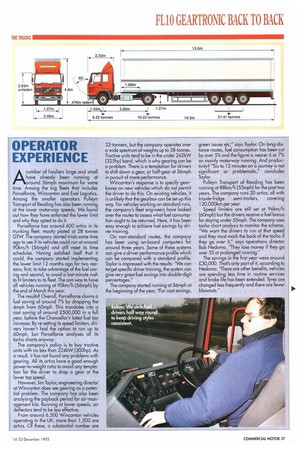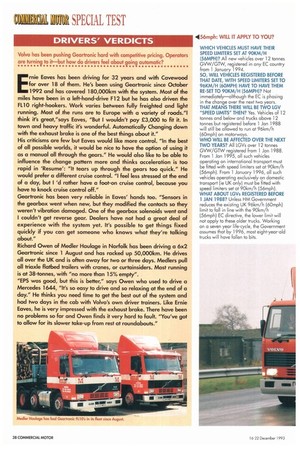OPERATOR EXPERIENCE
Page 39

Page 40

If you've noticed an error in this article please click here to report it so we can fix it.
Anumber of hauliers large and small have already been running at round 56mph maximum For some time. Among the Pig Fleets that includes Parcelforce, Wincanton and Exel Logistics. Among the smaller operators Pulleyn Transport of Reading has also been running at the lower motorway, speeds. We found out how they have enforced the lower limit and why they opted to do it.
Parcelforce has around 600 artics in its trunkinc: fleet, mostly plated at 28 tonnes GTW. The company started trials some time ago to see if its vehicles could run at around 90km/h (56mph) and still meet its time schedules. Having satisfied itself that it could, the company started implementing the lower limit 12 months ago for two reasons; first, to take advantage of the fuel saving and second, to avoid a last-minute rush to fit limiters to its Fleet. The aim was to have all vehicles running at 90krn/h (56mph) by the end of March this year. The results? Overall, Parcelforce claims a Fuel saving of around 7% by dropping the 4mph from 60mph. This translates into a cost saving of around .2500,000 in a full year, before the Chancellor's latest Fuel tax increase. By re-setting its speed limiters, drivers haven't had the option to run up to 60mph, but Parcelforce analyses all its tacho charts anyway.
The company's policy is to buy tractive units with no less than 224kW (300hp). As a result, it has not found any problems with gearing. All its artics have a good enough power-to-weight ratio to avoid any temptation for the driver to drop a gear at the lower top speed.
However, Jim Taylor, engineering director at Wincanton does see gearing as a potential problem. The company has also been analysing the payback period for air-management kits. Running at lower speeds, air deflectors tend to be less effective.
From around 6,500 Wincanton vehicles operating in the UK, more than 1,500 are artics. Of these, a substantial number are
32-tonners, but the corn oany operates over a wide spectrum of weigtIts up to 38-tonnes. Tractive units tend to be in the under 242kW (325hp) band, which is why gearing can be a problem. There is a temptation for drivers to shift down a gear, or half-gear at 56mph in pursuit of more performance.
Wincanton's response is to specify gearboxes on new vehicles which do not permit the driver to do this. On existing vehicles, it is unlikely that the gearbox can be set up this way. For vehices working on standard runs, the company's fleet engineers have looked over the routes to assess what fuel consumption ought to be returned. Here, it has been easy enough to achieve fuel savings by driver training. On non-standard routes, the company has been using on-board computers for around three years. Some of these systems can give a driver performance profile which can be compared with a standard profile. Taylor is impressed with the results: 'We can target specific driver training, the system can give very great fuel savings into double-digit percentages." The company started running at 56mph at the beginning of the year, 'For cost savings, green issues etc," says Taylor. On long-distance routes, fuel consumption has been cut by over 5% and the figure is nearer 6 or 7% on mainly motorway running. And productivity? "Six to 12 minutes on a journey is not significant or problematic," concludes Taylor. Pulleyn Transport of Reading has been running at 881(m/h (55mph) for the past two years. The company runs 20 artics, all with triaxle-f ridge semi-trailers, covering 120,000km per year. Speed limiters are still set at 96km/11 (60mph) but the drivers receive a Fuel bonus for staying under 55mph. The company uses tacho chart analysis to monitor the scheme. "We want the drivers to run at that speed and they must mark the back of the tacho if they go over it," says operations director Bob Nedoma. 'They lose money if they go over 55 at prolonged running." The savings in the first year were around 230,000. That's only part of it, according to Nedoma: 'There are other benefits, vehicles are spending less time in routine services and brake life has been extended. Tyres are changed less frequently and there are fewer blowouts."
WHICH VEHICLES MUST HAVE THEIR SPEED LIMITERS SET AT 90KM/H I56MPH)? All new vehicles over 12 tonnes GVW/GTW, registered in any EC country from 1 January 1994.
SO, WILL VEHICLES REGISTERED BEFORE THAT DATE, WITH SPEED LIMITERS SET TO 96KM/H (60MPH) HAVE TO HAVE THEM RE-SET TO 90KM/H (56MPH)? Not immediately—although the EC is phasing in the change over the next two years. THAT MEANS THERE WILL BE TWO LGV "SPEED LIMITS" THEN? Yes. Vehicles of 12 tonnes and below and trucks above 12 tonnes but registered before 1 Jan 1988 will still be allowed to run at 96km/h (60mph) on motorways.
WHO WILL BE AFFECTED OVER THE NEXT TWO YEARS? All LGVs over 12 tonnes GVW/GTVV registered from 1 Jan 1988. From 1 Jan 1995, all such vehicles operating on international transport must be fitted with speed limiters set at 90km/h (56mph). From 1 January 1996, all such vehicles operating exclusively on domestic transport (ie UK only) must be fitted with speed limiters set at 90km/h (56mph). WHAT ABOUT LGVs REGISTERED BEFORE 1 JAN 1988? Unless HM Government reduces the existing UK 96km/h (60mph) limit to fall in line with the 90km/h (56mph) EC directive, the lower limit will not apply to these older trucks. Working on a seven year life-cycle, the Government assumes that by 1996, most eight-year-old trucks will have fallen to bits.




















































































